
Emille Galle cameo glass Solifleur vase, c.1905, trumpet shape, signed
Emille Galle cameo glass Solifleur vase, c.1905, fire polished, with trumpet shaped neck above slender ovoid body, decorated with hanging flowers and foliage, in tones of brown on a yellow and green ground, signed Galle, height 13 cm

Art Nouveau Cameo Glass Vase in Galle Style, Lavender Ground
An Art Nouveau cameo glass vase, in the manner of Galle, the long neck vase with fused cut designs in blue and black over a pale lavender ground, height 24.5 cm, diameter 8.5 cm

Emile Galle Pink Gradient Glass Vase with Flower Design
A Emile Galle pink gradient glass vase featuring flowers, height 16 cm

Emile Galle Long Neck Cameo Glass Vase with Purple Vines
Emile Galle (French, 1846-1904), long neck cameo glass vase, acid-etched decoration of purple flowering vines, against white opaque ground, acid etched signature to side 'Galle', height 39 cm. Provenance: Fontaine's auction gallery, Massachusetts, 2020.…

Emile Galle Brown Glass Vase with Gum Leaves Decoration
Emile Galle (French, 1846-1904), cameo Art glass vase, of baluster form, brown glass with acid-etched decoration of gum leaves, acid etched signature to side 'Galle', a chip glued back to the base (A/F), height 20 cm. Provenance: Maison R&C,…

French Galle cameo glass vase, c.1900, signed, floral decoration, 8.5cm
French Galle cameo glass vase, c.1900, of squat baluster form, decorated with sprays of flowers and foliage, in tones of green, brown and pink, signed, a/f, height 8.5 cm

French cameo glass vases in Emile Galle style, grapevine motif
A pair of French cameo glass vases in the style of Emile Galle, waisted baluster vases with grapevine and trailing fruit motifs in fire polished chocolate colours upon a white satin ground, faint signature of Galle in relief to lower bodies, 24.5 cm high

Emile Galle cameo glass flask vase, autumnal leaf design
An Emile Galle cameo glass flask vase, after 1904, the cushion form vase with applied twin handles featuring a trailing leaf and fruit design in autumnal tones on a modulating lemon and amber ground, ground pontil and signed in cameo with posthumous star,…

Antique French Galle Cameo Glass Vase, 27.5 cm High
Galle antique French cameo glass vase, 27.5 cm high

Emile Galle Convolvulus Vase: Blue on Yellow Cameo Glass
Emile Galle, Convolvulus vase. Cameo glass, blue on yellow ground. Signed 'Galle'. Height 26.5 cm

Galle Gooseberry Cameo Glass Vase, 1927-1936
A Galle cameo glass bottle vase, 1927-1936, with elongated neck, overlaid and acid etched in red glass with gooseberries and leaves, cameo signature to body. Height 32 cm. Provenance: The Estate of the Hon. Dr John Kennedy McLaughlin Am, Sydney

Authentic Emile Galle Art Nouveau Orchid Vase (c. 1900)
Genuine Emile Galle (French 1846-1904) Art Nouveau cameo glass 'Orchid' vase circa 1900

Lilac Wisteria: Small Acid Etched Vase, Signed (13cm)
Small Galle acid etched vase, ovoid shape, decorated with wisteria in lilac and green colours, signed, 13 cm high

Signed Galle Wisteria Acid Etched Glass Vase, 31cm High
Large Emile Galle acid etched ovoid glass vase, decorated with wisteria in lilac and green, signed, 31 cm high
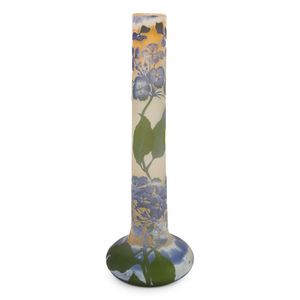
Emile Galle Art Nouveau Cameo Glass Vase
An Art-Nouveau cameo glass vase by Emile Galle (1846-1904), a three colour long-necked vase with a compressed base decorated with lilac flowers and foliage upon a muted frosted ground, signed Galle in cameo to the lower body, with a ground pontil, height…

Galle's Amber Cameo Glass Perfume Atomiser
A cameo glass perfume atomiser by Emile Galle (1846-1904), the slender conical bottle featuring strappy foliage and swaying flower stems and berry clusters upon an amber ground, signed in cameo to the lower body, the silvered mounts marked made in France,…

Emile Galle cameo glass perfume atomiser with silvered mounts
A cameo glass perfume atomiser by Emile Galle (1846-1904), the cylindrical atomiser with carved and polished russet flowers on a tomato red ground, signature in cameo to the body, with a ground pontil, original paper label to base with handwritten…

Emile Galle Faience Cat Figurine with Floral Decoration
Rare Emile Galle faience cat figurine signed E Galle Nancy depose, with parts of original purchase sticker, with ornate handpainted floral decoration, dog cameo collar and glass set eyes, height 33 cm

Ferns on Galle Cameo Glass Vase
Galle cameo glass vase, of petit ovoid form, decorated with various ferns, in tones of brown and green, signed, height 12 cm

Galle Art Nouveau Miniature Cameo Glass Vase
Galle French Art Nouveau miniature purple floral cameo glass vase, early 20th century, signed 'Galle', 8.5 cm high

Galle Art Nouveau Orange Cameo Glass Vase
Galle French Art Nouveau orange and opaque cameo glass vase, early 20th century, signed 'Galle', 5.5 cm high, 7.5 cm diameter
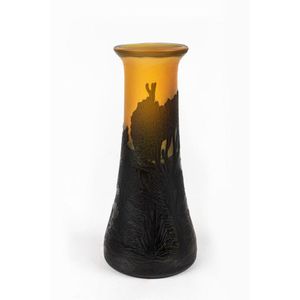
Emile Galle Forest Cameo Flask Vase
A cameo glass flask vase by Emile Galle, French, circa 1900, a forest and mountain scene in muted olive, brown and blue colours against a deep golden ground, cameo signature of Galle to body, 19 cm high
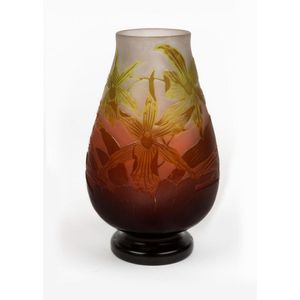
Emile Galle Wild Orchid Cameo Glass Vase
A cameo glass vase by Emile Galle, French, circa 1900, featuring wild orchids in chartreuse and russet colours against an ombre ground, cameo signature of Galle to lower body, 13 cm high

Galle Style Faience Cat with Blue Hearts and Circles
A Galle style faience cat, white glaze with cobalt blue with hearts, circles and keyhole decorative motifs. Glass eyes. Impressed mark to the base '1889', height 16 cm

Empire Ware Ceramic Cat with Turquoise Cape
An Empire Ware ceramic cat. C.1896-1919 white cat with green glass eyes. Galle style. With turquoise cape patterned all over with flowers and gliding. Restoration to right front leg and crack to front, height 35.5 cm

Amber and Pink Cameo Glass Vase with Floral Design
A small Galle style cameo glass vase flask shape with tall neck. Amber frosted, cased in clear deep pink. Flowers and foliage, height 13 cm

Embossed Landscape Glass Vase - 34cm Height
Galle style decorated glass table vase embossed Landscape decoration, height 34 cm.

Floral Galle Style Cameo Glass Vase (15cm)
Galle style cameo glass vase with floral decoration, height 15 cm

Floral Cameo Glass Vase with Twin Handles
Galle style cameo glass twin handle vase with floral decoration, height 13.5 cm

Galle Floral Cameo Glass Vase (9.5 cm)
Antique Galle cameo glass small vase with floral decoration, signed to base, height 9.5 cm.

Galle-Style Cameo Glass Vase, 20th Century
A cameo glass vase in the Galle style, 20th century, 43 cm high

Mauve Floral Galle Cameo Glass Vase
A French Galle cameo glass vase, the body with a floral acid etched design in shades of mauve over a frosted ground. Signed 'Galle', height 24 cm, diameter 10.5 cm

French Galle Cameo Glass Vase with Floral Design
A French GalleCameo glass vase, the body has a floral acid etched design in purple, over a pale green frosted ground. Signed 'Galle', height 37 cm, diameter 10 cm

Galle Floral Cameo Glass Vase
A French Galle cameo glass vase, the body with a floral acid etched design in shades of mauve and yellow on a frosted ground. Some wear. Signed 'Galle', height 20.5 cm, width 13 cm, depth 10 cm

French Galle Cameo Glass Vase with Floral Design
A French Galle cameo glass vase, the body has a floral acid etched design, overlaid in orange glass on a white ground. Etched 'Galle' near base, height 26 cm

French Galle Floral Etched Glass Vases
A pair of French Galle cameo glass vases, both with a floral acid etched design in green on pink ground. Both etched Galle near base. Largest height 7.5 cm, diameter 5.5 cm
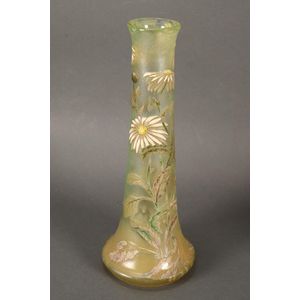
Emile Galle Cameo Glass Vase with Daisies and Foliage
Large Emile Galle cameo glass vase, c.1900, of tapering cylindrical form, decorated with daisies and foliage, with enamel highlights, in tones of green, white and purple, acid etched signature, height 47 cm Provenance: collection of Hans and Gertrud…

Galle Pomegranate Vase, 1910
Good Galle cameo vase, c.1910, with spreading cylindrical neck above a squat baluster body, decorated with pomegranate and foliage, in tones of red and orange signed, height 15 cm
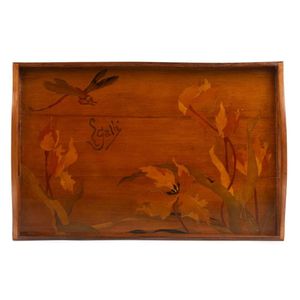
Signed Emile Galle Art Nouveau Serving Tray
Emile Galle French Art Nouveau marquetry serving tray, circa 1900, signed 'E. Galle' in the design, 59 cm across the handles
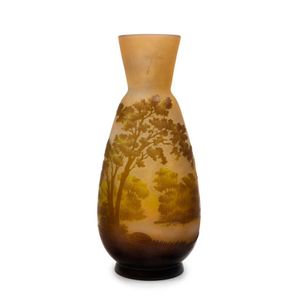
Autumn Landscape Galle Style Cameo Glass Vase
A Galle style cameo glass landscape vase, circa 1900, in delicate autumn tones, with etched 'Galle' signature to lower body, 26 cm high

Galle Cameo Glass Vase with Waterlillies
A cameo glass vase by Galle; the flattened ovoid body decorated with waterlillies and other aquatic flora in deep purple signed with cameo mark 'Galle' preceded by a star to body. Height 24 cm. Provenance: Christie's Australia, Melbourne, 29 March 1993,…

Fruit and leaf adorned Galle cameo glass vase
Galle style cameo glass vase adorned with fruit and leaves, 20th century, 30 cm high

Galle Floral Cameo Glass Vase, Signed, 10.5cm Height
Antique Galle cameo glass small vase with floral decoration, signed to base, height 10.5 cm small chip to rim.
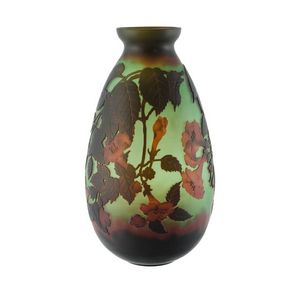
Green and Red Floral Cased Glass Vase
Large Galle style cased glass vase. Green cased glass vase with red floral overlay. Height 35 cm

Galle Etched Glass Vase with Anemone Flowers
A Galle violet and yellow etched glass vase, French, circa 1900, of compressed ovoid form decorated with anemone flowers, etched 'Galle' signature, 13.5 cm high

Opalescent and Enamelled Glass Vase by Emile Galle
Emile Galle (French 1846 - 1904), 'Tempus Stellae' a twin-handled opalescent and enamelled glass vase, circa 1900, the green glass ground with bands of opalescence and textured finish, acid etched with floral design and star motifs, heightened with…

Autumnal Floral Acid Etched Glass Atomiser
Galle acid etched glass atomiser, floral design in autumnal colours signed, (hose detached) 23 cm high

Autumnal Berries Etched Glass Vase
Galle style acid etched glass vase, tapering form decorated with berries and leaves in autumnal colours, 31 cm high

Galle's Purple River Vase
Emile Galle (1846-1904), a cameo glass elongated ovoid vase, carved with a continuous river landscape in shades of purple, cameo signature, reduced in height. Height 29 cm. Provenance: from the collection of Sir George and Lady Proud

Cameo Glass Vase by Emile Galle
Emile Galle (1846-1904), a small cameo glass elongated ovoid vase, carved with a spray of flowers and foliage in shades of pink and mauve, cameo signature. Height 14 cm. Provenance: from the collection of Sir George and Lady Proud

Emile Galle Cameo Glass Vase with Scenic Design
Rare French Emile Galle cameo coloured and layered glass vase of a boat shape, decorated with trees, mountains and riverscene to both sides, signature 'Galle' to the lower right. (Private Adelaide Collection) 18 x 13 cm

Emile Galle Wisteria Cameo Glass Vase
A French Art Nouveau cameo glass vase, 'Wisteria', by Emile Galle, circa 1900, the pink glass body of tapered form with a flared rim, with lavender cameo and acid etched overlay in a wisteria motif, 'Galle' cameo signature, 29.8 cm high

Galle Floral Glass Bowl, 10 cm
Small Galle acid etched glass bowl decorated with flowers and leaves, signed, 10 cm diameter.

Galle Cameo Glass Vase with Pendant Flowers
Emile Galle (1846-1904) A cameo glass vase, circa 1900 overlaid and acid-etched with pendant flowers and leaves, signed in cameo Galle 12 cm high
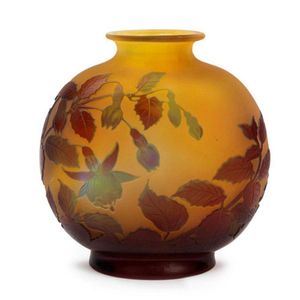
Galle Fuchsia Cameo Glass Vase
Emile Galle (1846-1904) A cameo glass vase, circa 1900 overlaid and acid-etched with fuchsia flowers and leaves on a translucent yellow ground, signed in cameo Galle 15 cm high
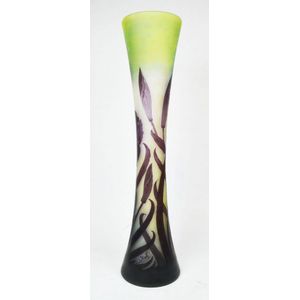
Emile Galle Flowering Plant Cameo Glass Vase
An Emile Galle cameo glass vase circa 1900. Depicting a flowering plant. Signed 'Galle' height: 57 cm

Galle Cameo Glass Vase with Mountain Frieze
Lovely Galle cameo glass vase, with a spreading lip above an ovoid body, decorated with a continuous frieze depicting trees, river and mountains, in tones of yellow, blue and green, signed Galle, on circular foot, height 32 cm

French Galle Cameo Floral Trinket Box with Restoration
1920's French Galle cameo lidded trinket box with floral decoration, signed around base, width 18 cm approx stapled and painted restoration

Blue and Brown Galle Cameo Glass Vase, c.1910
Galle cameo glass vase, c.1910, of ovoid form, decorated with leaves and flowers rising from the ground, in tones of blue and brown, height 18 cm

Fuchsia Floral Cameo Glass Bowl - 11cm Width
Galle style glass bowl with floral Fuchia and leaf cameo decoration, width 11 cm

Galle Tulip Specimen Vase
Late 19th century/ early 20th century Galle specimen vase, elongated frosted tinted yellow body with double overlay red to pink continuous tulips, signed, still with remains of paper label, 25 cm height

Galle Peruvian Primrose Cameo Glass Vase - 20cm
A cameo glass vase, decorated in Peruvian Primrose, signed Galle, height 20 cm.

Ferns & Grass Bowl
Emile Galle, Fougeres bowl, C.1900, tinted glass with a gradation of vibrant greens, engraved decoration of ferns and blades of grass. Engraved signature. Height 12 cm, width 20 cm
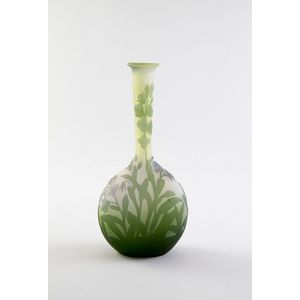
Signed Art Nouveau Glass Vase, 17cm Height
Galle Art Nouveau acid etched glass vase, bottle shaped, signed, 17 cm height
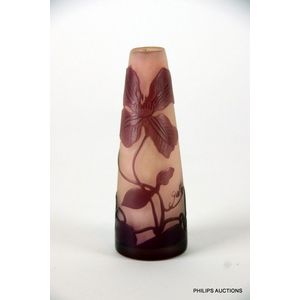
Art Nouveau Galle Cameo Vase
A small Art Nouveau cameo vase by Galle, circa 1900, the vase with a polished purple cameo flower, buds and tendril style foliage, upon a matte pink mauve ground, cameo signature to lower body, shallow, polished pontil underside, height 10.5 cm

Emile Galle cameo glass vase
A cameo glass vase by Emile Galle (1846-1904), tapering in form with a flared rim, overlaid with a foliage design, signed 'Galle' toward the base, 48.5 cm high

Emile Galle Style Brown and White Cameo Vase
An Emile Galle style cameo cut vase, brown on a white ground, 28.5 cm high.
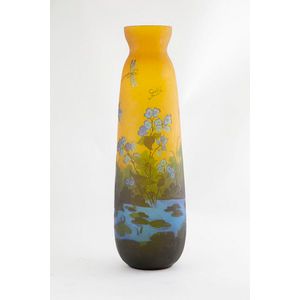
Galle's Pond Scene Cameo Glass Vase
Art Nouveau style cameo glass mantle vase, elongated cylindrical form, blue and green layers on amber of continuous pond scene bearing the signature of Galle, 64 cm height

Galle Waterlily Cameo Glass Vase
A fine cameo glass vase by Emile Galle, circa 1900, a refined tapering vase with a compressed base overlaid with an acid etched, and polished design of waterlilies, lily leaves, sinuous foliage and other, blooms in subtle aubergine and smoky blue grey…
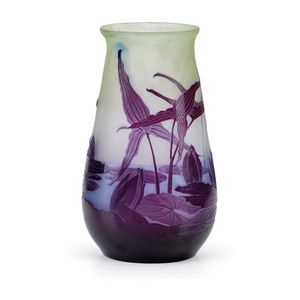
Etablissement Galle Cameo Glass Vase with Water Lily Design
An Etablissement Galle 'Water Lily' cameo glass vase, French, circa 1910, the flattened cylindrical body with an acid-etched design, in colours of mauve and blue, on a frosted pale yellow ground, acid-etched 'Galle, 24 cm high. Provenance: Decorative Arts…

Etablissement Galle Cameo Glass Vase, French, c. 1910
An Etablissement Galle 'Hydrangeas' cameo glass vase, French, circa 1910, the flattened cylindrical vase with an acid-etched design, in colours of brown and blue on a graduating yellow and blue ground, acid-etched 'Galle, 18.5 cm high. Provenance:…
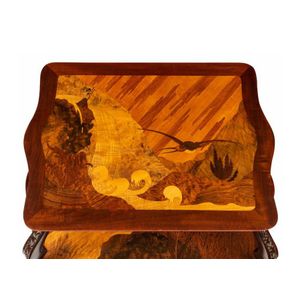
French Art Nouveau Drinks Trolley with Marquetry Inlay
Emile Galle (attributed) French Art Nouveau drinks trolley, marquetry inlaid with lift-off tray top and ormolu fittings, circa 1900, 81 cm high, 75 cm wide, 61 cm deep

French Galle Cameo Glass Bud Vase with Leaf Decoration
1920's French Galle cameo glass bud vase leaf decoration, signed around base. Height 12 cm

Galle Floral Cameo Glass Bowl - Signed
Galle cameo glass bowl, of baluster form, decorated with a raised ground of flowers in tones of purple and green, signed, height 10 cm
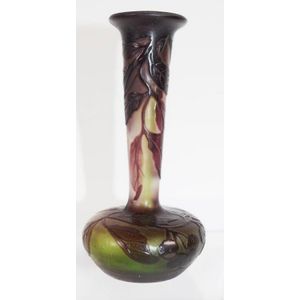
French Galle Cameo Glass Bud Vase with Leaf Decoration
1920's French Galle cameo glass bud vase leaf decoration, signed around base, height 12 cm

Signed Emile Galle Overlay Vase with Oak Design
Emile Galle (1846-1904) signed French overlay vase, Oak leaves & acorn design, 21 cm high

French Iris Cameo Glass Vase by Galle, 1910
An Etablissement Galle 'Iris' cameo glass vase, French, circa 1910, the waisted cylindrical vase with an acid-etched design, in shades of mauve on an etched ground, acid-etched 'Galle, 19 cm high. Provenance: Fine European and Oriental Furniture, Ceramic…

Etablissement Galle 'Daisies' Cameo Glass Vase, French, 1903
An Etablissement Galle 'Daisies' cameo glass vase, French, circa 1903, the waisted cylindrical body with an acid-etched design, in colours of red and brown on a graduated yellow ground, acid-etched 'Galle, 32 cm high. Provenance: P.L. Pickles & Co.,…
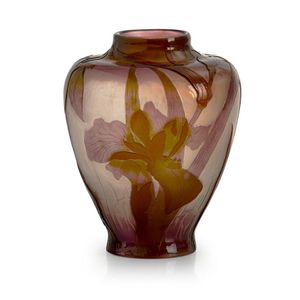
Emile Galle Iris Fire Polished Cameo Glass Vase
An Emile Galle 'Iris' fire polished cameo glass vase, French, circa 1900, the baluster body etched and carved in lavender and brown glass on an opaque ground, cameo carved 'Galle, 25 cm high. Provenance: Mr Hans Mueller and Mrs Gertrud Mueller, Sydney.

Galle Eucalyptus Cameo Glass Vase, French 1910
A Etablissement Galle 'Eucalyptus' cameo glass vase, French, circa 1910, the tall tapering body with an acid-etched design, on a frosted graduated green and white ground, acid-etched 'Galle, 31.5 cm high. Provenance: Mr Hans Mueller and Mrs Gertrud…

Etablissement Galle 'Violets' Cameo Glass Vase
An Etablissement Galle 'Violets' cameo glass vase, French, circa 1910, the slender bottle shaped vase with an acid-etched design, overlaid in mauve glass on a mottled yellow and white ground, acid-etched 'Galle, 23.5 cm high. Provenance: Mr Hans Mueller…

Galle 'Iris' Cameo Glass Vase, French, c. 1910
An Etablissement Galle 'Iris' cameo glass vase, French, circa 1910, the teardrop body with an acid-etched design, in shades of blue on a frosted pale yellow ground, acid-etched 'Galle, 24 cm high. Provenance: Mr Hans Mueller and Mrs Gertrud Mueller,…
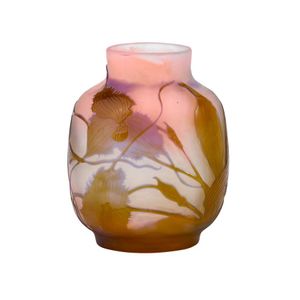
Emile Galle Orchid Vase, French, 1904
An Emile Galle 'Orchid' vase, French, circa 1904, the flattened ovoid body with an acid-etched design, overlaid in aubergine and mauve glass on a mottled pink ground, acid-etched 'Galle' preceded by a star, 15 cm high. Provenance: Christie's Australia,…

Etablissement Galle 'Grapes' Cameo Glass Vase
An Etablissement Galle 'Grapes' cameo glass vase, French, circa 1910, the teardrop body with an acid-etched design, overlaid in brown glass on a graduating frosted white and pink ground, acid-etched 'Galle, 29.5 cm high. Provenance: Mr Hans Mueller and…

Rare Etablissement Galle 'Cherries' Souffle Cameo Glass Vase
A rare Etablissement Galle 'Cherries' mould-blown souffle cameo glass vase, French, circa 1915, the baluster body with acid-etched and mould-blown decoration, in shades of red on an etched yellow and opaque ground, above a spreading circular foot,…

Rare Etablissement Galle 'Cherries' Souffle Cameo Glass Vase
A rare Etablissement Galle 'Cherries' mould-blown souffle cameo glass vase, French, circa 1915, the baluster body with acid-etched and mould-blown decoration, in green, brown and clear glass, on an etched ground, above a spreading circular foot,…

Emile Galle 'Anemone' Cameo Glass Vase
An Emile Galle 'Anemone' cameo glass vase, French, circa 1903, the tapering cylindrical body with an acid-etched design, overlaid in orange glass on a graduated white and orange frosted ground, acid-etched 'Galle, 31 cm high. Provenance: Mr Hans Mueller…
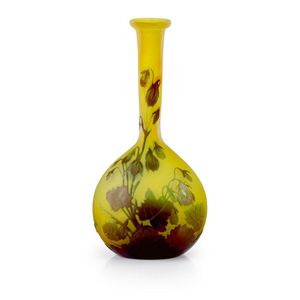
Etablissement Galle Cameo Glass Vase, French circa 1915
An Etablissement Galle 'Columbines' cameo glass vase, French, circa 1915, the bottle shaped body with an acid-etched design, in green and purple glass on a yellow ground, acid-etched 'Galle, 17 cm high. Provenance: Leonard Joel, Melbourne, 25 July 1988.…

Emile Galle Daisy Cameo Glass Vase
An Emile Galle cameo glass vase, French, circa 1900, the tall tapering body with an acid-etched and enamelled design depicting daisies on a sea green ground, acid-etched 'Galle, 47 cm high. Provenance: Mr Hans Mueller and Mrs Gertrud Mueller, Sydney.

Galle Floral Overlay Bud Vases (Set of 3)
Emile Galle, three glass bud vases, overlaid and acid-etched with floral sprays, signed in cameo 'Galle' (3), height 18 cm, height 16 cm

Opalescent Hawthorn Vase by Emile Galle
Emile Galle, large cameo glass vase, c. 1900, the slightly opalescent body overlaid and acid-etched with leafy branches of hawthorn, on circular spreading foot, signed in cameo 'Galle' near base (A/F), height 42.5 cm
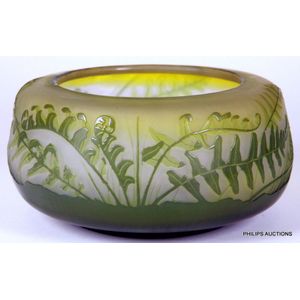
Emile Galle Art Nouveau Cameo Glass Bowl
An Art Nouveau cameo glass bowl by Emile Galle, circa 1900, a bowl of compressed form with an inverted collar, decorated in the round with fern leaves and fronds in shades of green upon a frosted paler green ground, having a polished rim and ground pontil…




 Loading more...
Loading more...